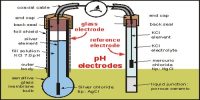We can combine equilibrium reactions whose Kc values are known to obtain Kc for the overall reaction
Combining rules
- If a reaction is reversed, invert the value of Kc.
- If each of the coefficients in an equation is multiplied by the same factor (2, 3 etc), raise Kc to the same power (2, 3 etc).
- If each coefficient in an equation is divided by the same factor (2, 3, etc), take the corresponding root of Kc (i.e., square root, cube root, etc).
- When the individual equations are combined/added together, take the product of the equilibrium constants to obtain the overall Kc.
Equilibrium constant for the sum of reactions
For example, nitrogen and oxygen can combine to form either NO (g) or N2O (g) according to the following equilibria.
(1) N2 (g) + O2 (g) ↔ 2NO (g) Kc1 = 4.1 x 10-31
(2) N2 (g) + ½ O2 (g) ↔ N2O (g) Kc1 = 2.4 x 10-18
Using these two equations, we can obtain Kc for the formation of NO (g) from N2O (g):
(3) N2O (g) + ½ O2 (g) ↔ 2NO (g)












